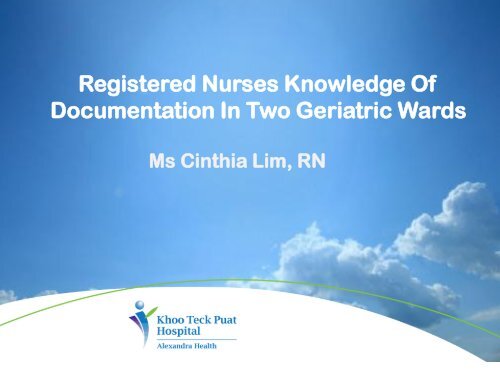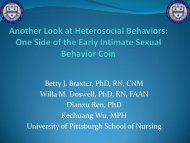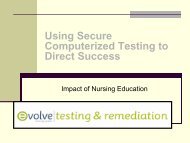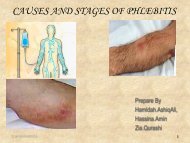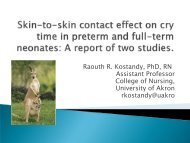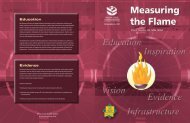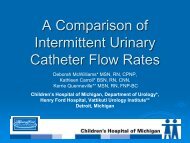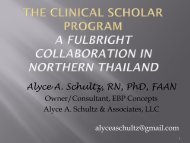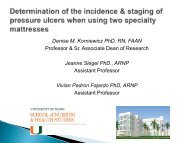Lim, Cinthia - IUPUI
Lim, Cinthia - IUPUI
Lim, Cinthia - IUPUI
You also want an ePaper? Increase the reach of your titles
YUMPU automatically turns print PDFs into web optimized ePapers that Google loves.
Registered Nurses Knowledge OfDocumentation In Two Geriatric WardsniceMs <strong>Cinthia</strong> <strong>Lim</strong>, RN
Introduction• The intention of nursing documentation is todemonstrate that an organization maintainscomprehensive written evidence of its planning,delivery, assessment and evaluation of patient’scare.• These records also serve as legal documentsand for meeting accreditation requirements.(Crisp &Taylor, 2004)
Nursing Documentation• The purpose of nursing documentation is tocommunicate health information, facilitate qualityassurance and research, and demonstrate nurses'accountability. Registered nurses knowledge ofnursing documentation is important.• The purpose of these records are also importantfor the delivery of quality assessment and nursingcare. (Ehrenberg & Ehnfors, 2001)
Literature Review• Edelstein (1990) devised a questionnaire toassess nurse’s knowledge of attitudes towardsdocumentation in care environments.• The 22 item instrument included 8 items thatmeasured knowledge and 14 that assessedattitudes.
Literature Review• Forms used in documentation were listed andparticipants were asked to rate them in order ofimportance (1=never- 5=always).• The study had shown that the direct relationshipbetween documentation and the assessment ofcare outcomes is an important aspect of nursingto examine.
Research Outcomes• The testing employed a modified version of thequestionnaire devised by Edelstein (1990) andacquired RN’s knowledge of nursingdocumentation in geriatric wards.
Geriatric Wards
Research Problem• There was little known about the relationshipbetween registered nurses’ (RNs’) knowledge ofnursing documentation and their attitudestowards this documentation process in thegeriatric ward.
• Attitudes and Knowledge about Documentationscale• A modified version of the 22-item questionnairedevised by Edelstein (1990)
Aims• This study aim was to investigate the registerednurses’ knowledge of, and attitudes towards thedocumentation used in two geriatric wards..
Method
Method• The study used a cross-sectional descriptivedesign with a sample of RNs (n = 30) with leasttwo years of post- accreditation.• Edelstein (1990) questionnaire was modified tosuit the Singaporean context.
Method• The modified questionnaire included 8 items fromEdelstein’s questionnaire together with 8additional items related to geriatric care. Itincludes a five-point Likert scale (from 1=never-5=always).▫ The modified questionnaire used was to identify factorsthat influence nurses’ documentation.
•Modified 16-itemquestionnaire.•Items in redreflects geriatricrelatedquestions
Method• After modification, the questionnaire was pilotedwith a group of five RNs who were considered tobe similar to the participant sample.• They found the questionnaire to be clearlyexpressed and its items readily addressed andindicated that no further modifications wererequired.
Method• Following ethical approval from Khoo Teck PuatHospital’s Ethics committee, the RNsparticipated in the survey.• The answers to the questionnaires were put in asealed envelope and returned to the principalinvestigator.
Method• Data collection was done September toNovember 2010.• Data were analysed using the StatisticalPackage for the Social Sciences (SPSS version18.0)
RESULTS
RN Knowledge Responses:Descriptive• The mean and standard deviation of eachknowledge item are displayed withrankings from the highest to the lowestmean.
RN Knowledge Responses:DescriptiveThe highest mean score was elicited for two items:• Item 1: Nurses are familiar with policies ondocumentation.• Item 2: Written discharge instructions are given.This suggests that in general, RNs are most aware ofpolicies on documentation and the writing of dischargeinstructions.
RN’s Knowledge Responses:Factor Analysis• The 16 items in the knowledge scale of thequestionnaire showed excellent reliability.• The results further supported the claim that theknowledge scale appropriately measured RN’sknowledge of documentation.
Discussion
Discussion• The findings revealed that the RNs in thesample have high levels of knowledge aboutdocumentation, with the mean scores in eachitem positive.▫ This outcome is consistent with the results of previousstudies which have used the Edelstein questionnaire(Ehrenberg & Ehnfors, 1999b, 2001; Ehrenberg,2001).
Discussion• International studies have also reported thatRNs had sufficient knowledge of documentationguidelines to meet accreditation andorganizational requirements and to meetpatient’s needs. (Hansebo et.al 1999, Tolstonet.al 2005).
Discussion• Attention needs to be directed atimproving RNs’ understanding of what iswritten and it’s requirements, for it’sextremely difficult to carry out intentionsformulated by others without clearguidelines.
Discussion• A lot of studies have also indicated that a lack ofeducation of RNs could contribute to thelimitations affecting what is written in nursingdocumentation and when it is read. (White,1998; Irving & Watts, 2006)▫ What one RN considers important andsignificant enough to record and read, othersmay deem less so.
Discussion• RNs display a low status to reading and writingnotes (Ehrenberg, 2001).• Therapists and doctors tend to documentactivities as soon as they occur. Whereas RNstend to document activities whenever the time isavailable and it can be fitted into their workload(Taylor, 2003).
Discussion• RNs often complete writing up their patient’sdocumentation after their shifts have actuallyfinished (Pabst et.al, 2006).• While RNs may identify and recognize healthcare needs at the appropriate moment, theymay not have the time immediately to documentthe care delivered. Inevitably they maysometime fail to complete it at a later time.
Discussion• RNs also do not have any office space or otherquiet environment available to undertake theirdocumentation duties.• Some RNs may decide not to complete theirnursing documentation confronting thembecause they do not believe there is sufficientbenefit in doing so.
Discussion• RNs were familiar with documentation policiesas well. However it was still reiterated to themthat the work instruction and policy ondocumentation existed.• It is apparent that RNs familiarity of suchpolicies existing did not impede theirunderstanding of documentation requirements(Hogan, 2004).
Relevance To Clinical Practice• The findings suggest that the modified Edelstein(1990) questionnaire has potential as aneducational and clinical guide in the geriatricwards.• The reliability and validity tests conductedsupport this claim along with the fact that theresults were similar to studies using samplesfrom other countries.
Relevance To Clinical Practice• When RNs are faced with documentation andcompliance issues, this questionnaire can beadministered to identify which factors impedeand which facilitate nursing care documentationin geriatric wards.• An advantage of the questionnaire is thatbecause it can be completed within a shortperiod time, it is appropriate for use in-servicetraining sessions.
Study <strong>Lim</strong>itations• The RN participant, (n=30) is not generalizable to thelarger nursing population.• The self reporting nature of the questionnaire allowedparticipants’ scope to state what they believe RNsshould know about nursing documentation rather thanrating their own individual knowledge of it.▫ In spite of these potential limitations, self –report isacknowledged as an effective means of investigatingvalues and attitudes (Kermode & Roberts, 2006).
Study <strong>Lim</strong>itations• Several issues influenced the results for theknowledge and attitude scales:▫ Knowledge factors such as care-reportingguidelines,▫ Nurse time issues,▫ Legal issues▫ Quality of reporting.
Study <strong>Lim</strong>itations• Attitudes were influenced by charting, practiceand policy issues. These findings provideimportant information on what variables affectRNs’ documentation.
Conclusion• This study determined that RNs working ingeriatric wards had sound knowledge of nursingdocumentation requirements.• These results have important implications for thenursing process framework used to underpinRN’s documentation practices.
Conclusion• The RNs surveyed did not view the componentsof the nursing process as the most importantaspects of documentation, thus suggesting thattheir priorities are to be found in other influenceson their knowledge of what is involved. This isan area that warrants further investigation.
References1. Crisp & Taylor (2004). Potter and Parry’s Fundamentals of Nursing, 2 ndedn. Elsevier, Sydney.2. Edelstein, J (1990). A study of nursing documentation. NursingManagement, Chicago, 21, 40-46.3. Ehrenberg, A & Ehnfors, M (1999a). Patient problems, needs and nursingdiagnoses in Swedish nursing home records. Nursing Diagnosis ,10, 65-76.4. Ehrenberg, A & Ehnfors, M (1999b). Patient records in nursing homes:Effects of training on content and comprehensiveness. ScandinavianJournal of Caring Science, 13, 72-82.5. Ehrenberg, A ( 2001). Nurses perception concerning patient records inSwedish nursing homes. Vard I Norden, 21, 9-14.6. Ehrenberg, A & Ehnfors, M (2001). The accuracy of patient records inSwedish hospitals : congruence of record content and nurses’andpatients’description. Scandinavian Journal of Caring Science, 15, 303-310.
References7. Hansebo G , Khilgren M & Ljunggren G (1999). Review of nursingdocumentation in nursing home wards- changes after intervention forindividualized care. Journal of Advanced Nursing, 29, 1462-1473.8. Hogan WP (2004). Structuring the process of nursing caredocumentation on the basis of a theoretical process model. Journal ofAdvanced Nursing, 18, 292- 301.9. Irving, K & Watts, A. (2006). Discursive practices in the documentation ofpatient assessments. Journal of Advanced Nursing, 18, 19-27.10. Lobiondo-Wood G & Haber J (2006). Nursing Research: Methods,Critical Appraisal and Utilization, 7 th e.d. Mosby: St. Louis.11. Kermode S & Roberts K (2006). Qualitative methods in research andhealth care: Evidence Based Practice in Nursing, 33, 300-309.12. Korst LM, Eusobio-Angelja AC, Chamorro T, Aydin C & Gregory, KD(2003). Nursing Documentation time during implementation of electronicmedical record. Journal of Nursing Administration, 33, 24-30.
References13. Martin A, Hinds C & Felix M (1999). Documentation practices of nurses inlong term care. Journal of Clinical Nursing, 8, 345-352.14. Pabst MK , Scherubel JC & Minnick AE (1996). The impact ofcomputerized documentation on nurses’ use of time. Computers inNursing, 14, 25-33.15. Pelletier D, Duffield C, Gietzelt D, Larkin P & Francis H (2002). Thecomplexities of documenting clinical information Gerontology units .Journal of Gerontological Nursing, 28, 8-18.16. Pelletier D, Duffield C, & Donoghue J (2005). Documentation and thetransfer of clinical information in two aged care units . Australian Journalof Advanced Nursing , 23, 51-59.17. Taylor H (2003). An exploration of the factors that affect nurses’ recordkeeping. British Journal of Nursing,13, 753-781.
References14. Tolston D, Maclaren W, Kiely S & Lowndes A (2005). Influences ofpolicies on nursing practice in aged care environments. Journal ofAdvanced Nursing, 55, 777- 793.15. White, J. (1998). Bad nursing records will make nursing scholarshipsuspect. Journal of Advanced Nursing, 3, 3-11.


